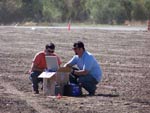
A Call for Uniform Groundwater Classification
Groundwater is critically important. According to the U.S. Environmental Protection Agency, more than 50 percent of all Americans and more than 95 percent of rural Americans obtain their household water supplies from groundwater. It also supplies approximately half of the nation’s agricultural needs and almost one-third of the industrial sector’s needs.
However, a comprehensive national program to protect this valuable resource is not in place. Instead, protecting groundwater involves a complex myriad of federal, state, tribal and local statutes, regulations and policies. As a result, considerable variation exists with regard to
- its definition and classification
- programmatic objectives for protection and restoration and
- reporting, enforcement, and response to contamination
This kind of regulatory complexity and variability inherently leads to inconsistency, gaps, and wastefulness. This is especially true when you consider that all groundwater is not useable. In applying the nation’s limited environmental protection resources, the government is spending considerable sums of money to clean up groundwater resources that may never be used, and in other cases, parties are degrading potential groundwater resources but are not being held responsible for their actions.
The first step to promoting a consistent and practical approach to groundwater protection and restoration is to develop and implement a comprehensive and uniform classification system. In other words, “If we can’t agree on what groundwater is, how can we agree on how to protect it?”
The federal government classified groundwater in its definition of an Underground Source of Drinking Water (USDW), which was promulgated under the Safe Drinking Water Act of 1974. A USDW contains a sufficient quantity of groundwater to supply a public water system and currently supplies drinking water for human consumption, or contains less than 10,000 milligrams per liter (mg/L) of total dissolved solids (TDS).

Saltwater intrusion forced Brunswick, Ga., to abandon the well for drinking water, so the U.S. Geological Survey started monitoring it for water levels and specific conductance. An agency employee performs maintenance on the monitoring unit. Photo courtesy of Alan Cressler, U.S. Geological Survey.
The definition is based on the idea that groundwater should be protected if it can produce a sufficient quantity to serve as drinking water and if it has a sufficient quality to serve as a current or future drinking water source. By setting the quality standard at 10,000 mg/L TDS, EPA extended protection to groundwater sources that would require treatment in the future.
In 1984, the federal agency issued its Groundwater Protection Standard, a policy that recognized that different sources of groundwater required different levels of protection. EPA developed a three-tiered classification system as the model for implementing federal groundwater protection policy:
- Class I – special groundwater
- Class II – groundwater not currently and potentially a source for drinking water
- Class III – groundwater not a source of drinking water.
Class I sources are of unusually high value but highly vulnerable to contamination and are irreplaceable sources of drinking water and/or ecologically vital.
Class II sources include all non-Class I groundwater currently used, either by existing drinking water wells (or springs) or if the source is within a water supply reservoir watershed. Potential sources of drinking water also fall within this class, and they are defined as, “capable of yielding a quantity of drinking water to a well or spring sufficient for the needs of an average family…with a TDS concentration of less than 10,000 mg/L, which can be used without treatment, or which can be treated using methods reasonably employed in a public water system. The sufficient yield criterion has been established at 150 gallons/day.”
Class III includes sources that are saline (TDS greater than 10,000 mg/L), or that are so contaminated by naturally occurring conditions or the effects of broad-scale human activity (unrelated to a specific activity) that they cannot be cleaned up using treatment methods reasonably employed in public water supply systems. This type also includes sources that yield less than 150 gallons per day.

Hydrologists monitor data collection during a geophysical survey in Rhode Island using the horizontal-to-vertical ambient-noise seismic method. Photo courtesy of USGS Office of Groundwater, Branch of Geophysics
EPA intended the classification process to be conducted on a site-by-site basis rather than on a regional or aquifer-specific basis, and its program offices and state agencies were to be responsible for EPA-delegated programs. EPA acknowledged that many states had already implemented groundwater classification systems. Recognizing this, EPA stated that “State agencies responsible for managing groundwater will not be required by the EPA to adopt the classification system for general program use.”
State agencies could use the federal classification for some sites and state classification for others, if a state system was in place. The Groundwater Protection Standard had the beginnings of a consistent and uniform classification system, but implementation ─ in the name of flexibility and reliance on subjective and qualitative terms (e.g., “highly vulnerable,” “irreplaceable” and “ecologically vital”) ─ diminished its national value.
In January 1990, the Environmental Law Institute (ELI), on behalf of the EPA Office of Groundwater Protection, conducted a survey that showed that more than half of the states had adopted groundwater protection policies, and the majority of these states had groundwater protection policies based on specific use, value, or vulnerability. Twenty-two states had a formal system for assigning aquifers to different specific groundwater classes based on use, hydrogeology, quality, or some other factor. However, the ELI report noted that “There is little consistency between them as regard to either the number of classes or the basis for classification.”
The findings of the ELI study provided convincing evidence that the framework for protecting and classifying groundwater was largely inconsistent and non-uniform, and many states had not developed formal classification systems. The report also made clear that states had not followed EPA’s lead by adopting the three-tiered classification system.
To further complicate matters, EPA issued a new Strategy for Protecting the Nation’s Groundwater in July 1991. The emphasis of the strategy was to focus on prevention of groundwater contamination through comprehensive resource management at the state level. Under this approach, states were expected to take into account the total impact of all sources of contamination, as well as the unique hydrogeologic features of their groundwater resources. Factors to be considered in developing and implementing protection programs included the use, value and vulnerability of their groundwater resources as well as social and economic values.
EPA issued the Final Comprehensive State Groundwater Protection Program Guidance document in December 1992. The document describes the basis for Comprehensive State Groundwater Protection Programs (CSGWPPs) as the primary mechanism for groundwater protection. Six strategic activities, including resource characterization (another way of saying groundwater classification), are described as fundamental elements of the programs. EPA expected states to develop this type of protection program over the next several years.
Resource characterization in the guidance is overly complex. It includes consideration of intrinsic sensitivity, quantity and potential yield, background water quality, potential for remediation, current use, reasonably expected future use (based on demographics, land use and other factors), values (including intrinsic value) attributed to groundwater resources, interactions and potential contamination impacts between surface and groundwater, the value of groundwater quality to the maintenance of ecosystem integrity and inter-jurisdictional characteristics. These economic and other qualitative terms further complicated classification and promoted inconsistency. Only 11 states had met the first level or “core” requirements of the CSGWPP approach by 1999.
Recent activity on groundwater classification has predominantly occurred at the state level. In 2003, the Texas Commission on Environmental Quality (TCEQ), as part of its Texas Risk Reduction Program rule (TRRP), issued guidelines for identifying groundwater bearing units (GWBUs) and developed a three-tiered system (Class 1, 2 and 3) for classifying GWBUs based on current use, water quality and sustainable well yield and developed a quantitative definition for non-groundwater bearing units.
Class 1 groundwater is a “primary resource,” Class 2 is a “potential resource” and Class 3 is a “non-potential resource.” Each class has a comprehensive quantitative definition. As an example, Class 3 GWBUs are characterized by the following: the affected groundwater zone could not impact any existing water supply well within 0.5 miles, and a GWBU is not capable of producing greater than a 150 gallon per day groundwater flow from a single 4-inch diameter well, with a TDS content less than 10,000 mg/L. TCEQ’s definition of Class 3 groundwater is similar to EPA's 1984 Class III groundwater description.
As part of the TRRP, TCEQ formalized a Groundwater Classification Process:
1. Identify affected and interconnected groundwater bearing units.
2. Characterize current groundwater use (field reconnaissance within 500 feet and records search for wells within 0.5 miles of affected property).
3. Evaluate natural groundwater quality (TDS content by EPA Method 160.1).
4. Estimate representative well yield (idealized well function equation or direct well yield test).
While Texas and other states have developed and modified their groundwater programs, these classification systems continue to be inconsistent with each other.
The United States should conduct a comprehensive evaluation of state groundwater classification programs to provide a basis for developing a uniform system. Groundwater classification criteria should be limited to defined quantitative and qualitative terms that can be ranked. EPA could fund such a project or the American Society of Testing and Materials or the Ground Water Protection Council could develop a standard or guideline for a uniform classification system.
This endeavor is critically important to promote consistency for the many other elements of groundwater protection and restoration (e.g., cleanup standards, source siting restrictions, and institutional controls). Comprehensive groundwater protection must be founded on common, quantifiable terms that address the groundwater resource as a whole. This would not be the first time that such a uniform classification system has been proposed and successfully developed for a complex system with unique variations across states. One can simply point to the Unified Soil Classification System as an example of a functional classification system that is embraced by scientists across the country.
About the Author
Michael E. Covert, P.G., is the national director of environmental services with Terracon, an employee-owned engineering consulting firm providing geotechnical, environmental, construction materials and facilities services from more than 100 offices nationwide. Covert was formerly with U.S. EPA Region 6.